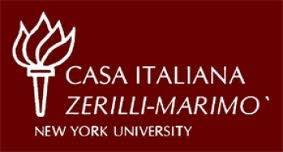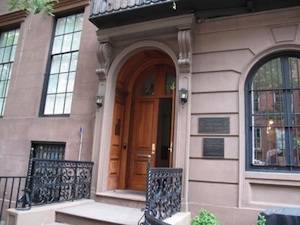The Zerilli-Marimò ‘Case’: NYU’s Casa Italiana Discussed at the University of Milan
p { margin-bottom: 0.08in; }
Casa Italiana Zerilli-Marimò was created thanks to Baroness Mariuccia Zerilli-Marimò in memory of her husband Guido, who was very close to Italian culture and the city of New York. The Baroness also made it the home of the Department of Italian Studies of New York University, previously merged to the French Department. With a 4 Million dollar donation, the beautiful Greenwich Village building was bought and restored. In 2010 Casa Italiana celebrated its 20th anniversary.
Prof. Giorgio Zanchetti coordinated the research of Lorenza Anselmi for the Cultural Heritage department of the Faculty of Art History of the University of Milan: an analysis of Casa Italiana’s activities from 1990 to 2010, which was concluded with the student’s defense of her thesis.
The objects of this study were Casa’s context, history, organizational model and cultural strategy.
First of all, Anselmi identified the specific traits of Italian culture in New York, the institutions and promotional initiatives present in the city: the Italian Cultural Institute, the Italian Academy of Columbia University, the Calandra Institute at the City University of New York, the Primo Levi Center, and MoMA PS1. All of these institutions has a different approach towards promoting Italian culture in a city that is very welcoming towards Italian production, whether classical or contemporary. The Calandra Institute, for instance, gives lots of space to Italian-American culture, while the Primo Levi Center concentrates upon the Italian Jewish community; other institutions, such as the Italian Academy focus on the more academic dimension.
Following is the study of the foundation of Casa Italiana, its birth, the history of the building, its juridical status, the economical aspect, the relationship with the Department of Italian Studies of New York University and the type of activities, divided among performances, music, literature, politics and economics, and visual arts. Finally, the study focuses upon the future and Casa’s public, through a research regarding the goals, the opinions, and levels of appreciation.
The work involved attentive archival research that took place in the fall of 2007. What resulted from the study is that Casa Italiana’s activity diversifies its proposals keeping into account both the historic and the contemporary dimension of Italian culture. Great attention is aimed at the visual arts and at young artists active during the last ten years. Apart from the tradition, Lorenza Anselmi points out how there is a large commitment towards the present: most of the time it is the Italy of the past that gets mentioned, the Roman Empire, the Renaissance, etc., forgetting the artistic and cultural expressions of today. Is Italy now only about food, fashion and design?
In answer to this the thesis demonstrates the large number of presentations by Italian-American writers of today organized by Casa Italiana. To be part of New York University allows the foundation to get close to themes of interest to the American world. The effort of the foundation is to give continuity to the proposed activities, succeeding in hosting a number of regular attendees, the ‘friends of Casa’, constantly kept up to date by the Casa website, videos and interviews regarding past events.
A future collaboration with Italian cultural centers and institution and a larger involvement of the younger generations should be researched as well. These are the conclusions of Lorenza Anselmi’s work: a piece of research that informed the Italian public about the constant commitment towards the promotion of Italy abroad. Italy often seems to forget its ‘cultural extensions’, in the prospective of telling more of itself abroad and obtaining feedback from a different kind of public, in an exchange that can only bring enrichment.









































i-Italy
Facebook
Google+
This work may not be reproduced, in whole or in part, without prior written permission.
Questo lavoro non può essere riprodotto, in tutto o in parte, senza permesso scritto.